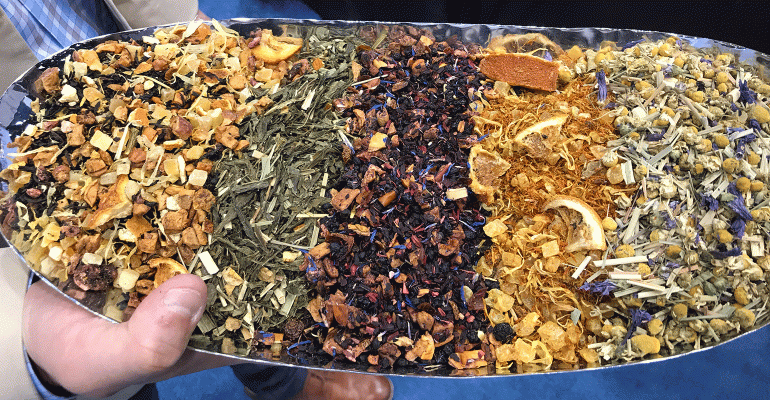 Nancy Kruse:
Nancy Kruse:
The only time we crossed paths in Chicago, Bret, was on the 9 a.m. shuttle to McCormick Place on Saturday morning. It was the lull before the annual NRA Show storm, both of us bright eyed, bushy tailed and running through our respective must-see lists. Less than a week has passed since that encounter, and, while battered, I am also unbroken, just barely, by the usual post-show overload.
As you know, this was a very special edition, the 100th anniversary of the event that began its long life in Kansas City, Mo., before finding its home in Chicago in 1950. It afforded an opportunity to reflect on the strength and vibrancy of our industry, and to ask if restaurateurs can sustain the same level of can-do creativity and energetic entrepreneurship for another hundred years. This last is strictly a rhetorical question, because the affirmative answer was in evidence everywhere on the floor of the show.
All in the family
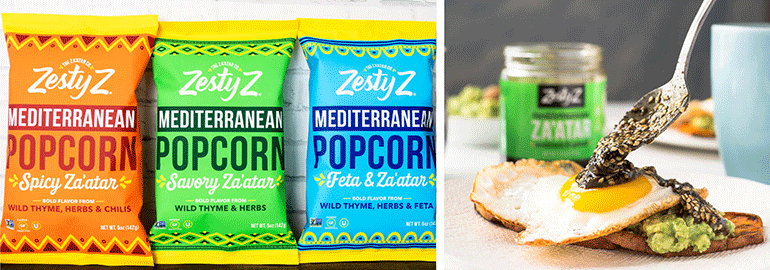
I am always struck by the extraordinary number of small businesses that support the industry, many of which, like the restaurants they serve, are family owned and operated. Among my favorites this year: Zesty Z, The Za’atar Company, which is run by Lorraine and Alexander Harik, a mother-son duo. Based in Brooklyn, N.Y., they built their business on her Lebanese recipe for the herbal condiment that’s prevalent across Mediterranean cuisines. Their website, which traces the roots of the product all the way back to biblical times, also touts their new line of distinctly unbiblical za’atar-spiked popcorn.
Like the company that they run, brothers Roberto and Francisco Pavan were born in Venezuela and raised in Los Angeles. Their Kumana brand of avocado sauces offers a delicious, pourable version of the wildly popular fruit that relies on their mother’s recipe. Roberto, the foodservice vice president, explained to me that they chose to market their products as avocado sauces rather than use the Venezuelan term “guasacaca.” They smartly reasoned that any name that included caca wouldn’t play well with an American audience.
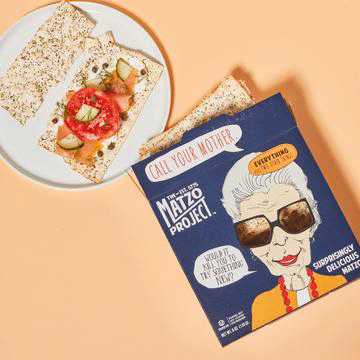 And I just loved the thoroughly modern matzo products from The Matzo Project, whose founders — lifelong friends from Brooklyn — built a better matzo. Their snappy crackers and chips come in fun flavors like cinnamon sugar and harissa, and their amusing and memorable packaging is pretty snappy too, with its bespectacled Jewish mother exhorting “Eat something. You look skinny,” among other typically Yiddishe-momme expressions.
And I just loved the thoroughly modern matzo products from The Matzo Project, whose founders — lifelong friends from Brooklyn — built a better matzo. Their snappy crackers and chips come in fun flavors like cinnamon sugar and harissa, and their amusing and memorable packaging is pretty snappy too, with its bespectacled Jewish mother exhorting “Eat something. You look skinny,” among other typically Yiddishe-momme expressions.
Coming to America
On a related note, I was constantly reminded that not only are we a country built by immigrants, but also that the restaurant industry is uniquely in their debt. Their continuing contributions stretch from the farm to the factory to the front of the house, a point that was driven home by Simona Faroni, cofounder of G.S. Gelato. When she and her husband moved here from Italy in 1996, they did not speak a word of English, but they were young, enthusiastic and believed in the American dream. And 23 years later they’re living it as the leading manufacturer of gelato for foodservice and private label.
Then there is the La family. Kim Su Tran La, her husband and their seven children fled Vietnam in 1980, landed in Houston and opened the perennially popular Kim Son restaurant. Her recipes are the basis for Mama La’s line of Vietnamese specialties like the East-meets-West Cajun boudin eggrolls and the soothing, restorative pho concentrates. As one of her sons ladled me a cup of aromatic beef broth, he mentioned that, at age 87, La puts in daily appearances at the plant to keep an eye on both her human and culinary progeny.
Designing women
The prominence of women business owners alongside all those indefatigable maternal recipe providers is an important example of how the industry values and rewards innovation. This was top-of-mind as I moseyed through the American Food Fair pavilion, always a favorite of mine. This year I was introduced to switchel, a vinegar-based beverage with a long history. Minnesotan Melina Lamer was seriously into ice hockey and looking for high-quality rehydration to sustain her exertions with the puck. The result is her Superior Switchel, which she created by combining apple cider vinegar and ginger with a range of other ingredients. It is both functional and lipsmacking.
In a booth nearby, Sue Kakuk, another Minnesotan, was handing out Kakookies, her better-for-you cookies, which she fabricated to be both nutritionally dense and comforting. The product evolved from her desire to provide her daughter, a competitive collegiate cyclist, with an attractive snack during her long rides.
Fortified by both switchel and Kakookie, I was able to navigate an additional half-dozen aisles, which brought me face-to-face with another resourceful woman, Christine Schindler, CEO of PathSpot, a scanner that instantly detects bacteria and viruses on the hands. I was relieved when my scan gave me a clean bill of health and engaged by the enthusiasm of Schindler and her cofounder, Dutch Waanders, neither of whom looks old enough to drive a car, but both of whom have leveraged their biomedical training and scientific smarts to benefit the foodservice business.
When Penny Met Sally
I was simultaneously interested and bemused by the latest generation of robotics on display in the Kitchen Innovations Showroom. I was interested to see how fast the field is evolving, as with Penny, a foodservice robot powered by artificial intelligence that acts as a combo food runner and busser; her offspring, available later in the year and known as Penny 2, will come with a tablet that will allow her to communicate with patrons and take their orders. Sally, by contrast, is a robotic server who dishes out fresh, made-to-order bowls, salads and snacks by means of sophisticated algorithms that allow her to dispense accurate portions of ingredients every time.
But here’s the thing that bemuses me, Bret. What’s up with the girly names? Why aren’t these machines dubbed Spike or Tommy, I wonder? Is there something less off-putting in the feminine identification, and, if so, will they soon begin spouting mom-isms and guilt-tripping us into calling home more often?
Little things mean a lot
The showrunners continue their improvements to make the show experience a bit less intimidating. It was nifty to be able to snag my badge from a special desk in the hotel before sprinting for the Saturday shuttle bus, and I was taken with the cheerful Chef Bot, an app which kept me apprised of what was happening on the show floor and responded like a flash to my queries. In fact, he/it was so unflappably responsive that I’m thinking of making him/it my CEO.
 Bret Thorn responds:
Bret Thorn responds:
I did enjoy printing my badge in the hotel lobby, Nancy, and sharing a bus ride with you to McCormick Place. I didn’t interact with Chef Bot, who contacted me as soon as I downloaded the show app. I didn’t have anything to say to the bot, but the app seemed to work well enough. However, I ended up taking a pretty low-key, holistic approach to the show, meandering its three massive halls to see what surprises I would find.
Plant-based everything
This wasn’t a surprise: There was a ton of plant-based protein at the show. There was the old-fashioned kind made with legumes and grain smashed into patties or textured into crumbles that might possibly be perceived as meat-like if you don’t normally eat meat and have a good imagination. And there were the higher-tech kinds, like those made by Beyond Meat and Impossible Foods that — well, they still don’t taste like meat, but they’re improving steadily and if you put enough condiments on them they’re close enough.

I think the award for most improved plant-based protein goes to Just, formerly known as Hampton Creek, inventor of the egg-free Just Mayo. Last year they rolled out Just Scramble, which is mostly made out of mung beans but behaves like scrambled eggs. People were wowed by it last year, even though it tasted like mung beans. But this year it was renamed Just Egg and it tasted more neutral, and the people running the booth cleverly sprinkled the omelets they made with black volcanic salt that contained traces of sulfur, so the product actually smelled like eggs.
“Plant-based” has become such a popular term that Country Crock was handing out chocolate chip cookies made out of its product instead of butter. There’s nothing new there except for nomenclature: Apparently the company that used to sell margarine is now selling “plant butter.”
CBD and spice
My credulity challenged, I wandered over to the Wisconsin dairy booth for some actual cheese, some of it with CBD added to it because of course it was, and then over to the New Mexico section for some Hatch green chile quesadillas. You had your pick of Hatch green chile stands at the show, Nancy, with at least four booths offering it. In fact, I think it was the chile of choice on the floor, despite new varieties of hot sauce, including Swamp Dragon, which has alcohol as its base instead of vinegar, and assorted variations of the fermented Korean chile paste gochujang.
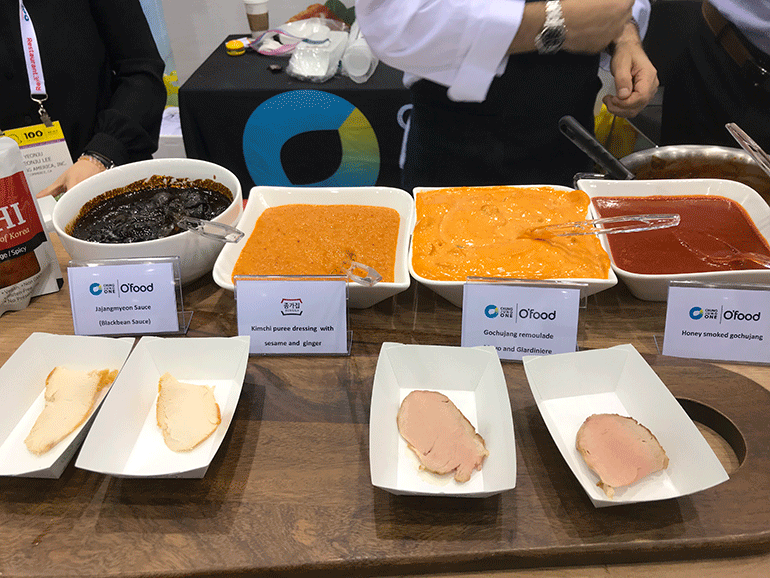
Other spicy items were in abundance, including Tyson’s new Nashville hot chicken and Hormel’s new line of pre-cooked bacon in glazes such as spicy guava.
On a sour note
I was quite taken with La Colombe’s new coffee shandy. Named after the beer-lemonade combination, it combines cold brew coffee and lemonade. It doesn’t sound particularly appealing, and it probably isn’t to everyone, but it surprised and delighted me as a quirky one-off product. Then I saw that Lavazza was making a beverage with cold brew coffee, orange juice, honey and rosemary. Coffee and citrus aren’t unheard of. In fact, it’s customary in parts of Europe to accompany espresso with a sliver of citrus zest, but it will be interesting to see how sturdy the legs are of this coffee shandy trend.
Or the shandy trend in general: Michigan-based Saugatuck Brewing Co., said their most popular beverage at the show was their Blueberry Lemonade Shandy.
Cold brew 2.5
Then there was the cold brew trend, which has now extended beyond coffee: Tiesta was proffering its cold brew tea, which can be made in just two hours instead of the 16 hours or more often required for coffee, and Twin Engine was making a cold-brew drink out of cascara — the fruit that surrounds the coffee “beans” (seeds, really) that we roast. Normally cascara is discarded, although Starbucks and other brewers have been making drinks out of it, and Twin Engine was steeping the cascara of a particular coffee varietal, which they’ve dubbed Caturra, into a tea-like cold-brew drink.
Sea-based protein
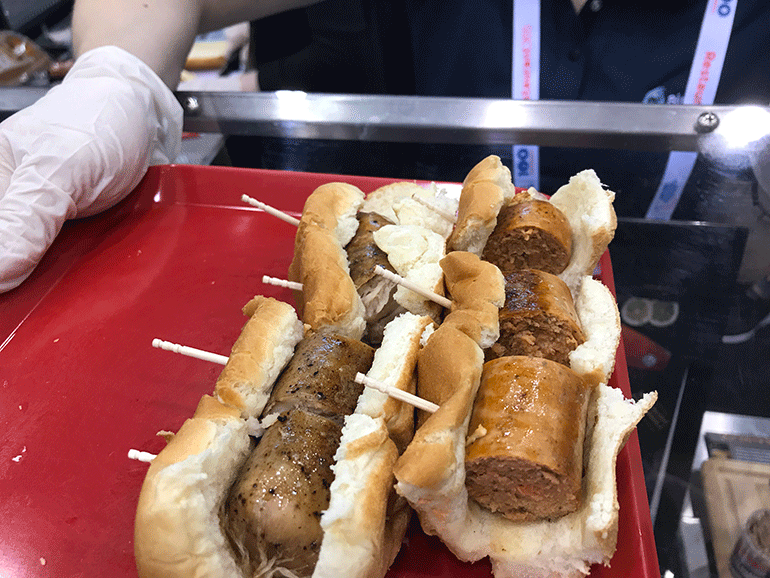
While plant-based meat analogs were clearly proliferating, so were new presentations of another type of protein: seafood. Those ranged from the value-added, pre-cooked frozen octopus that at least two companies were offering, to Trident Seafoods’ new protein noodles, made from pollock-based surimi seafood, to the products from Vancouver-based Simply West Coast, which included tasty salmon sausage and attempts at ham and bacon made from that same fish.
May 29, 2019 Update: This article has been updated to reflect a change in the name of Just Scramble to Just Egg.
Contact Bret Thorn at [email protected]
Follow him on Twitter: @foodwriterdiary
Nancy Kruse, president of the Kruse Company, is a menu trends analyst based in Atlanta and a regular contributor to Nation’s Restaurant News.
E-mail her at [email protected]

